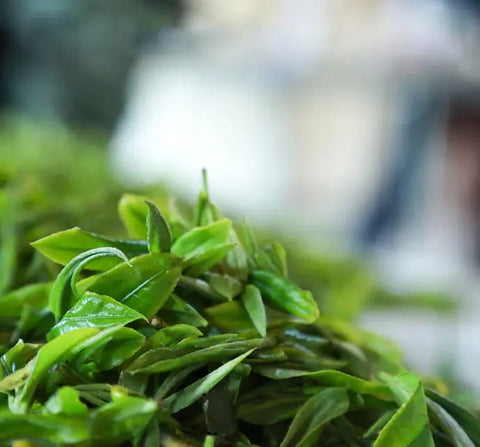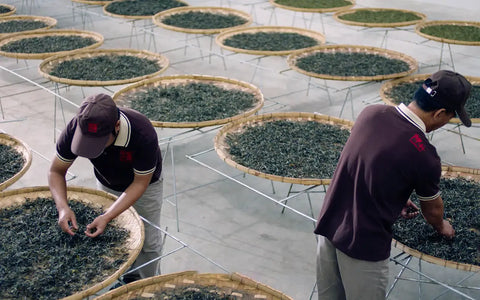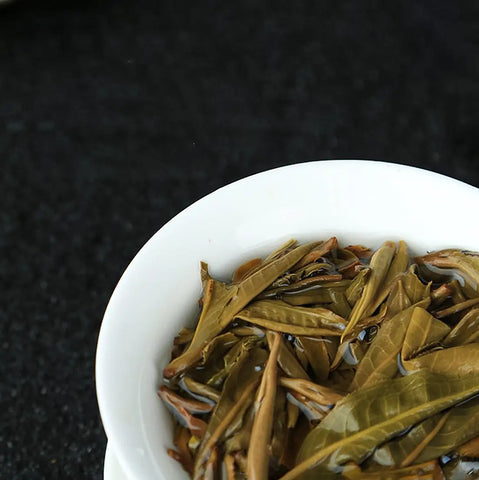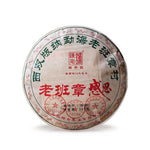Does Pu Erh Tea Have Caffeine? Exploring Its Stimulating Properties
Shop our Pu Erh Tea collections!
Pu-erh tea, a unique variety from China's Yunnan province, has gained popularity among tea enthusiasts worldwide. Many wonder about its caffeine content and how it compares to other teas. Pu-erh tea does contain caffeine, typically ranging from 30-70 mg per 8-ounce cup.
The exact amount of caffeine in pu-erh can vary based on several factors. These include the specific tea leaves used, processing methods, brewing time, and water temperature. Aged pu-erh teas often have slightly lower caffeine levels compared to their younger counterparts.
Bestsellers
If you're sensitive to caffeine or looking to reduce your intake, you can still enjoy pu-erh tea. Try shorter steeping times or blend it with herbal teas for a milder effect. Remember that pu-erh offers unique flavors and potential health benefits beyond its caffeine content.
Check out our Sheng pu erh tea collection and Ripe pu erh tea collection.
Key Takeaways
- Pu-erh tea contains caffeine, with levels varying based on processing and brewing methods
- You can adjust brewing techniques to control caffeine content in your pu-erh tea
- Pu-erh offers unique flavors and potential health benefits alongside its caffeine content
Caffeine Content in Pu-Erh Tea
Pu-erh tea contains caffeine, but the amount can vary based on several factors. The caffeine content typically ranges from 30-70 mg per 8-ounce cup.
Discover our best-selling raw Pu Erh tea and elevate your tea experience today!
Comparison to Other Teas
Pu-erh tea generally has less caffeine than black tea but more than green tea. A cup of black tea usually contains 60-90 mg of caffeine, while green tea has about 25-35 mg.
The caffeine content in pu-erh can change during the fermentation process. As the tea ages, the caffeine levels may decrease slightly.
Factors affecting caffeine content in pu-erh include:
- Tea leaf size
- Steeping time
- Water temperature
- Age of the tea
You can adjust the brewing method to influence caffeine levels. Shorter steeping times and lower water temperatures will result in less caffeine extraction.
It's worth noting that pu-erh tea often provides a smoother energy boost compared to coffee or other teas. This is due to the presence of L-theanine, an amino acid that can help balance the effects of caffeine.

Factors Affecting Caffeine Content in Pu Erh Tea
The caffeine content in pu erh tea can vary widely based on several key factors. These include the type of pu erh, how it's processed and aged, and how you brew it.
Influence of tea type (raw vs. ripe)
Raw and ripe pu erh teas have different caffeine profiles. Raw pu erh typically contains more caffeine than ripe pu erh. This is due to the processing methods used for each type. Raw pu erh undergoes minimal processing, preserving more of its natural caffeine content. Ripe pu erh, on the other hand, goes through a fermentation process that can reduce caffeine levels.
Lao Ban Zhang
The caffeine content in raw pu erh can be up to 70% higher than in ripe pu erh. You'll generally find 40-70mg of caffeine per cup in raw pu erh, compared to 30-50mg in ripe pu erh. These amounts can vary based on other factors like leaf quality and brewing method.
Impact of aging and fermentation process on caffeine levels
Aging and fermentation play crucial roles in pu erh's caffeine content. As pu erh ages, its caffeine levels gradually decrease. This is especially true for raw pu erh, which can lose up to 20% of its caffeine over 10-20 years of aging.
The fermentation process used to create ripe pu erh also affects caffeine. During fermentation, microorganisms break down some of the tea's compounds, including caffeine. This results in lower caffeine levels in ripe pu erh compared to its raw counterpart.
Longer fermentation periods generally lead to lower caffeine content. A heavily fermented ripe pu erh may contain 30-40% less caffeine than a lightly fermented one.
Role of brewing method and steeping time
How you brew your pu erh tea significantly impacts its caffeine content. Longer steeping times extract more caffeine from the leaves. A 1-minute steep might yield 30-40mg of caffeine, while a 5-minute steep could produce 50-70mg.
Water temperature also plays a role. Hotter water extracts caffeine more efficiently. Brewing with water at 95°C (203°F) will release more caffeine than using water at 80°C (176°F).
The number of infusions matters too. Pu erh can be steeped multiple times, with each subsequent infusion containing less caffeine. The first 2-3 infusions typically have the highest caffeine content.
Brewing method affects caffeine extraction as well. Gongfu-style brewing, which uses a high leaf-to-water ratio, can result in a more concentrated and caffeinated brew compared to Western-style brewing.

Health Implications of Caffeine in Pu Erh Tea
Caffeine in Pu Erh tea can have various effects on your health. Understanding these impacts can help you make informed decisions about consumption.
Benefits and potential drawbacks of caffeine consumption
Caffeine in Pu Erh tea can boost your energy and alertness. It may enhance cognitive function and improve physical performance during exercise.
Moderate caffeine intake can support weight loss efforts by increasing metabolism and fat oxidation. Some studies suggest it may reduce the risk of certain neurological disorders.
On the flip side, excessive caffeine can lead to jitters, anxiety, and sleep disturbances. It may cause temporary increases in blood pressure and heart rate.
Caffeine can be mildly addictive, and sudden withdrawal may result in headaches or fatigue. It's important to monitor your intake and listen to your body's responses.
Specific health benefits associated with Pu Erh tea
Pu Erh tea offers unique health benefits beyond its caffeine content. Research indicates it may aid in weight management by promoting fat breakdown and reducing fat storage.
The tea contains probiotics that support gut health, potentially improving digestion and nutrient absorption. Some studies suggest Pu Erh tea may help regulate cholesterol levels.
Pu Erh is rich in antioxidants, which can protect your cells from oxidative stress. These compounds may contribute to its anti-inflammatory properties.
Regular consumption might help stabilize blood sugar levels, making it beneficial for diabetes management. The tea's polyphenols could also support cardiovascular health.
Considerations for caffeine-sensitive individuals
If you're sensitive to caffeine, you should approach Pu Erh tea with caution. Start with small amounts to gauge your tolerance.
Opt for aged Pu Erh, which typically contains less caffeine than younger varieties. Consider brewing methods that extract less caffeine, such as shorter steeping times.
Decaffeinated Pu Erh options are available, allowing you to enjoy its other health benefits without caffeine's effects. Be aware that these may have slightly different flavor profiles.
If you experience adverse reactions, consult a healthcare professional. They can provide personalized advice based on your health status and sensitivity level.

How to Enjoy Pu Erh Tea with Controlled Caffeine Intake
Pu erh tea lovers can savor their favorite brew while managing caffeine intake. By adjusting brewing methods and exploring alternatives, you can find the right balance for your needs.
Tips for reducing caffeine content
Steep your pu erh tea for shorter periods to reduce caffeine content. A 30-second infusion extracts less caffeine than a 3-minute steep. Use cooler water, around 80°C (176°F), instead of boiling water.
Try rinsing the leaves before brewing. Pour hot water over the leaves, let it sit for 5-10 seconds, then discard. This quick rinse removes some caffeine.
Opt for larger, whole leaf pu erh teas. They release caffeine more slowly than broken or powdered leaves. Consider using fewer tea leaves per cup to further decrease caffeine content.
Alternative options for those looking to minimize caffeine
Explore decaffeinated pu erh teas. While less common, some producers offer decaf versions that retain much of the original flavor profile.
Try caffeine-free herbal alternatives that mimic pu erh's earthy notes. Rooibos and honeybush teas offer similar rich, full-bodied tastes without caffeine.
Roasted barley tea (mugicha) provides a nutty, toasted flavor reminiscent of aged pu erh. It's naturally caffeine-free and rich in antioxidants.
Consider blending pu erh with caffeine-free herbs like chamomile or peppermint. This reduces overall caffeine content while maintaining some pu erh characteristics.
Recommended daily intake of Pu Erh tea for balanced caffeine consumption
Limit your pu erh intake to 2-3 cups per day to maintain moderate caffeine levels. This typically provides 100-150mg of caffeine, well within recommended daily limits.
Space out your pu erh consumption throughout the day. Avoid drinking it late in the afternoon or evening to prevent sleep disruptions.
Pay attention to your body's response. If you experience jitters or anxiety, reduce your intake or switch to later infusions of the same leaves, which contain less caffeine.
Consider alternating between caffeinated pu erh and caffeine-free options throughout the day to balance your intake.
Storage and Aging Effects on Caffeine
Pu-erh tea's caffeine content can change during storage and aging. As you store pu-erh tea, its caffeine levels may decrease slightly over time.
The aging process can affect caffeine in different ways depending on storage conditions. Proper storage in a cool, dry place helps maintain more consistent caffeine levels.
Humidity and temperature fluctuations may impact caffeine content more significantly. Higher temperatures and moisture can potentially accelerate caffeine breakdown.
Oxidation plays a role in pu-erh tea aging. This process can gradually alter the tea's chemical composition, including its caffeine content.
Some studies suggest aged pu-erh may have lower caffeine levels than younger versions. However, the difference is often minimal and varies between tea samples.
The initial caffeine content of the tea leaves also influences how much remains after aging. Teas starting with higher caffeine levels may retain more over time.
Storage duration affects caffeine retention. Shorter storage periods typically result in less change to caffeine content compared to decades-long aging.
Packaging methods can impact caffeine stability during storage. Airtight containers help preserve caffeine better than more porous packaging options.
You can expect some variation in caffeine levels between different aged pu-erh teas. Factors like initial tea quality, processing methods, and storage practices all contribute to these differences.
Frequently Asked Questions
Is Pu Erh tea stronger than coffee?
Pu erh tea typically contains less caffeine than coffee. An average cup of pu erh has about 30-70 mg of caffeine, while a cup of coffee can have 95-200 mg. The exact amount depends on factors like brewing time and leaf quality.
Pu erh's caffeine content is similar to other teas, but it may feel stronger due to its rich flavor. Some people report a smoother energy boost from pu erh compared to coffee's more jittery effects.
Remember that individual responses to caffeine can vary. If you're sensitive to caffeine, start with small amounts of pu erh and adjust as needed.
Can I drink Pu Erh tea at night?
You can drink pu erh tea at night, but consider your caffeine sensitivity. While pu erh has less caffeine than coffee, it still contains enough to potentially disrupt sleep for some people.
If you're sensitive to caffeine, it's best to avoid pu erh in the evening. Try drinking it earlier in the day or opt for a caffeine-free herbal tea at night.
Some people find pu erh's unique compounds provide a calming effect, making it suitable for evening consumption. Experiment to see how it affects you, and adjust your drinking habits accordingly.
Does aged Pu Erh have more caffeine?
Aged pu erh doesn't necessarily have more caffeine than younger varieties. The aging process doesn't significantly increase or decrease caffeine content.
Factors like leaf quality, processing methods, and brewing techniques have a greater impact on caffeine levels. Larger, more mature leaves tend to have less caffeine than younger buds.
The perception of higher caffeine in aged pu erh may come from its stronger flavor and darker color. These characteristics don't directly correlate with caffeine content.
When brewing aged pu erh, use water slightly below boiling temperature and adjust steeping time to control caffeine extraction.
← Older post Newer post →












